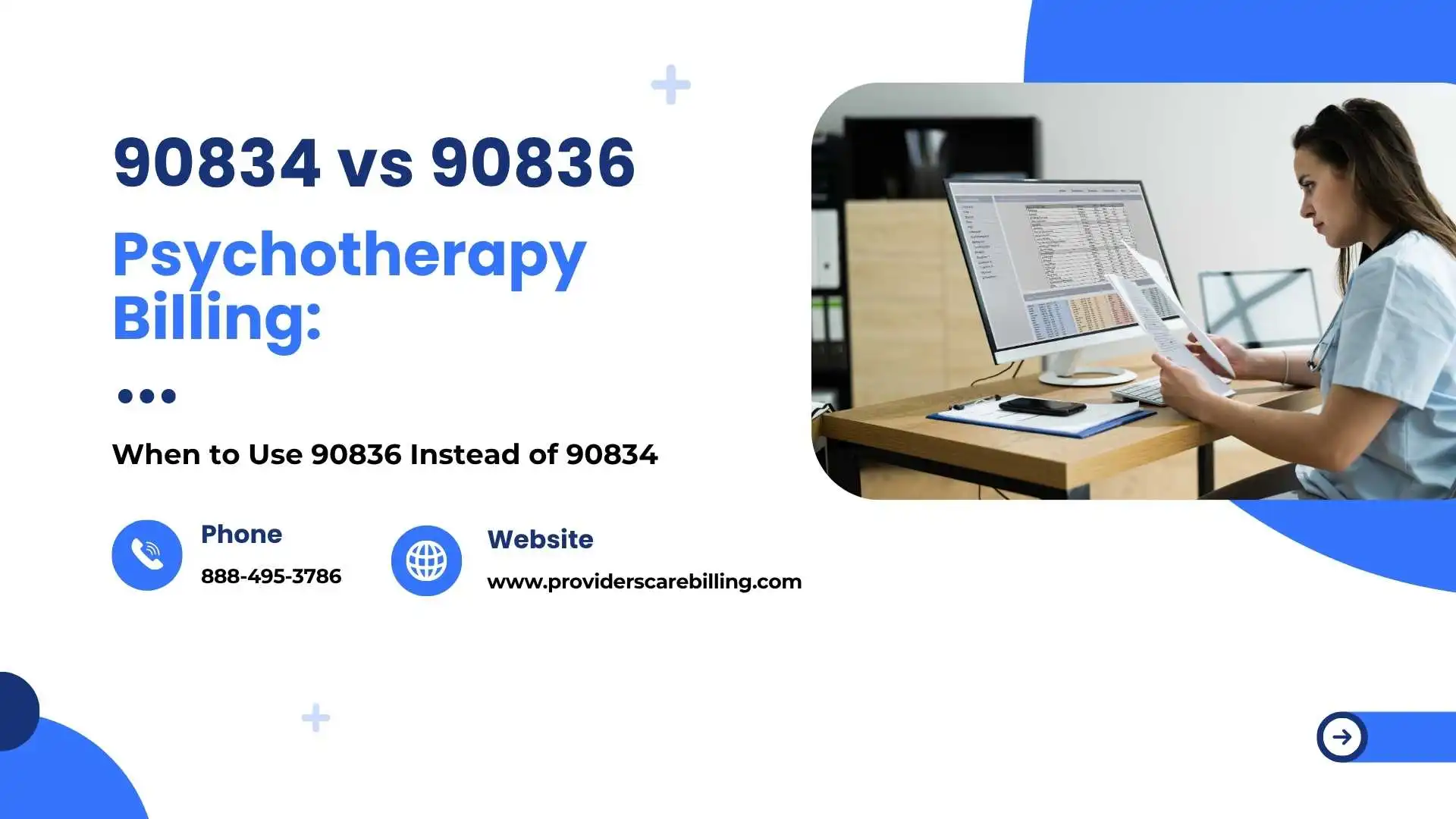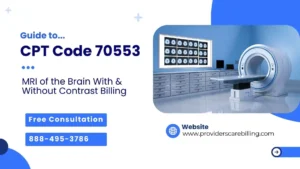Having precise billing in psychotherapy ensures both compliance and your practice’s financial health. Mental health billing is often tricky, especially when differentiating between very similar CPT codes. Between these are CPT 90834 and 90836, which are creating confusion for providers due to their similarity in type and time. The two codes apply to about a 45-minute psychotherapy CPT code, with the only difference being the ‘how’ and ‘when’ each code is utilized.
It is very important to select the accurate code to prevent denials, assurance reimbursement, and maintain compliance with payer policies. In this article, we’ll show you the difference between CPT 90834 and 90836 and will explain the scenarios in which each one should be applied.
What is CPT Code 90834?
90834 is the most commonly used code for mid mid-length individual psychotherapy session. It defines a psychotherapy session lasting about 38 to 52 minutes, making it a perfect fit for the standard 45 minutes of therapy.
· Time Limit: 38 -52 minutes
· Type: Standalone psychotherapy
· Used By: Psychologists, Licensed therapists, and psychiatrists.
Keep in mind that the CPT code for 45-minute psychotherapy is always coded as 9084 unless there is an E/M component available.
Use Cases
· Talk therapy is given due to depression or anxiety.
· Sessions focused exclusively on psychotherapy without medication management.
Mental health professionals working at CPMC physical therapy or comparable outpatient therapy centers often use this particular code. In cases when a patient is diagnosed with the F31.2 diagnosis code (bipolar disorder, current episode, manic with psychotic features), this code is only applicable if no medication review takes place.
What is CPT Code 90836?
90836 is an addition code that captures 45-minute psychotherapy sessions conducted alongside an Evaluation and Management (E/M) service. It explains that it is not a stand-alone code; it must be used with some E/M code, like 99213 or 99214, for medical evaluation.
· Duration: 38 – 52 minutes (same time duration as 90834)
· Type: Add-on psychotherapy with E/M
· Used by: Psychiatrists, psychiatric nurse practitioners, physician assistants
Based on the 90836 CPT code description, this code applies to only those cases where the patient is engaged in talk therapy with nurse practitioners and there is some form of medical evaluation and physical assessment performed, like a vital sign check (e.g., CPT code for vital signs).
Example: A psychiatrist supervises a patient’s medication for insomnia (CPT code insomnia) and conducts therapy for 45 minutes. Accurate billing would be the E/M code 99214 with add-on code 90836.
Comparison Table: 90834 vs 90836
| Feature | CPT 90834 | CPT 90836 |
| Type | Psychotherapy only | Psychotherapy + E/M |
| Duration | 38–52 minutes | 38–52 minutes |
| E/M Required? | No | Yes |
| Standalone Code? | Yes | No (Add-on only) |
| Used By | Therapists, psychologists, and psychiatrists | Psychiatrists, NPs, PAs |
This comparison table indicates that the main difference between these two codes lies in the addition of the E/M component and who uses it. If no medical assessment is made with the therapy, the correct billing code is 90834, and if it is used, then you should bill it as CPT 90863.
When to Use Each Code
Knowing when to apply each code is critical. Relate to the following practical examples:
Use CPT 90834 when:
· A psychologist renders 45 minutes of cognitive behavioral therapy.
· A licensed therapist conducts therapy for depression or anxiety without medication management.
Use 90836 CPT code when:
· A psychiatrist reviews lab results, modifies medications, and subsequently provides 45 minutes of psychotherapy.
· A psychiatrist checks vitals and discusses results while doing a therapeutic session.
Guidelines for proper Documentation
Accurate and comprehensive documentation is pivotal for claims to be processed appropriately and to confirm medical necessity. The following suggestions can help:
· Date and time for the session
· Make clear if the session was purely psychotherapy or psychotherapy with medical management.
· Highlight relevant patient symptoms, diagnoses (e.g., F31.2 diagnosis code), treatment objectives, and any progress made.
For the 90836 CPT code, never forget to add any component of the E/M, like medication changes, physical findings, or vital signs recorded.
Documents should be done in a standard template of electronic health records in order for all relevant information to be captured uniformly across different sessions.
Comprehensive documentation, while important for ensuring correct coding, must also safeguard providers from audits.
Other psychotherapy codes of equal relevance
In some instances, providers may use correlated codes like CPT 90863 when pharmacological management occurs without psychotherapy.
Another billing problem that comes up is the difference between 90834 vs 90837. The latter billing code is used for sessions lasting longer than 53 minutes, while 90834 and 90836, which cover the 45-minute sessions of therapy.
Use of Correct Modifiers
As online health services have continued to rise, many providers are now offering psychotherapy services online. If telehealth service means online psychotherapy is done, use the appropriate modifier, such as -95 with code like CPT 90834-95, to avoid any confusion in documentation.
Issues in Billing that Occur Frequently
The inadequate or incorrect application of these codes has the potential to incur denials, audits, or balance underpayment. Here are some common errors:
· Separate use 90836 without pairing it to an appropriate E/M code: This should always be done.
· Ignoring proof of basic and primary E/M services: Proof of basic and primary services needs to be included when submitting 90836.
· Using 90834 when E/M is involved: This increases the possibility of underpayment.
· Overlapping time documentation: Make sure all logbook entries contain the same data.
Recognizing the distinction in these codes can spare one from the complexities of billing and maximize operational efficacy.
Conclusion
Selecting between CPT 90834 and 90836 hinges on whether the psychotherapy visit includes a medical evaluation or not. When only talk therapy is performed, code 90834 suffices. Otherwise, 90836 is appropriate when E/M services, such as medication management or vitals review, are included.
Selecting a code impacts reimbursement and compliance. Consider payer-specific billing policies. Professional billing service will clarify, reduce errors, and ensure proper payment.
For additional guidance, examine CMS documentation or speak to a medical billing firm to bolster your practice’s billing efficacy and compliance with governing regulations.
For providers managing both psychotherapy and general medical services, it’s crucial to understand proper billing for additional procedures like ECG interpretations. Check out our CPT Code 93010: ECG Interpretation Billing Guide to avoid errors and improve reimbursement.




